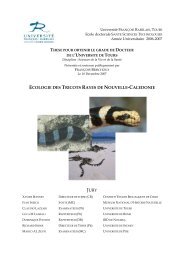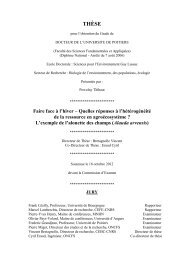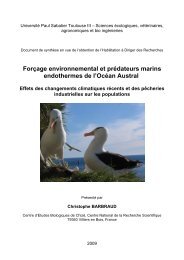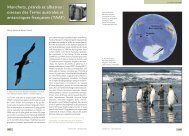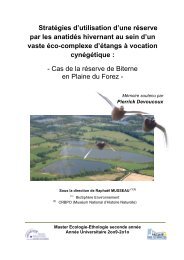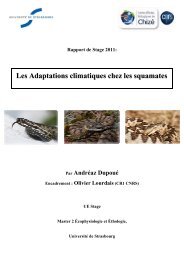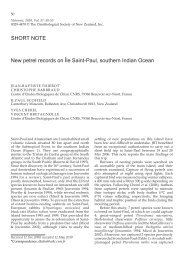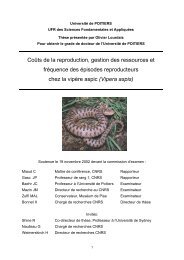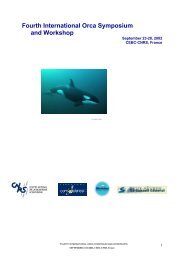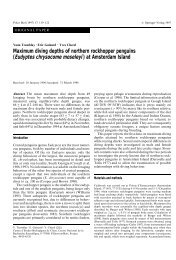Isotopic signatures, foraging habitats and trophic ... - Cebc - CNRS
Isotopic signatures, foraging habitats and trophic ... - Cebc - CNRS
Isotopic signatures, foraging habitats and trophic ... - Cebc - CNRS
Create successful ePaper yourself
Turn your PDF publications into a flip-book with our unique Google optimized e-Paper software.
156 Coral Reefs (2011) 30:155–165<br />
extinction (Van Valkenburgh et al. 2004) or result in<br />
complex coevolution between the predator <strong>and</strong> its prey<br />
(Reid 1991). Accordingly, considerable research has<br />
explored the reasons for dietary diversity (e.g., Schoener<br />
1971, 1974; Peckarsky 1982; Stephens <strong>and</strong> Krebs 1986;<br />
Greene 1986; Arnold 1993). That research has identified a<br />
range of ecological factors that can generate dietary<br />
divergence between any two predators: for example, a<br />
predator’s body size <strong>and</strong> shape may influence the<br />
feasibility of alternative <strong>foraging</strong> modes, e.g., ambush vs.<br />
wide-<strong>foraging</strong> (Secor 1995), its ability to locate, capture,<br />
overpower <strong>and</strong> ingest prey (Mittelbach 1981) or its ability<br />
to cope with toxins in the prey (Phillips <strong>and</strong> Shine 2005).<br />
Alternatively, different predators may forage in different<br />
<strong>habitats</strong> <strong>and</strong> hence encounter a different range of prey taxa<br />
(Holbrook <strong>and</strong> Schmitt 1992). In practice, many of these<br />
factors interact; for example, a predator unable to capture<br />
or ingest a large prey type will likely forage in <strong>habitats</strong> that<br />
maximize encounter rates with smaller (<strong>and</strong> thus, potentially<br />
edible) prey instead (Schoener 1971; Stephens <strong>and</strong><br />
Krebs 1986; Arnold 1993).<br />
Teasing apart the determinants of diet composition in<br />
predators is a challenging task, because of these multiple<br />
potential (<strong>and</strong> non-exclusive) mechanistic pathways. The<br />
task is simplified in systems that contain a suite of sympatric<br />
predators that differ in diets but are broadly similar<br />
in morphology, ecology <strong>and</strong> behavior—such as congeneric<br />
species, or age <strong>and</strong> sex classes within a single predator<br />
species. Because all of these animals potentially are<br />
exposed to the same suite of available prey, differences in<br />
dietary composition among <strong>and</strong> within species must be due<br />
to the kinds of factors identified above. In systems that<br />
facilitate direct observation of predator–prey encounters,<br />
we can evaluate issues such as <strong>foraging</strong> habitat use <strong>and</strong><br />
prey-h<strong>and</strong>ling ability. In most systems, however, encounters<br />
between predators <strong>and</strong> prey occur in situations (at<br />
night, inside shelter sites, etc.), where direct observation is<br />
impossible. Even if some encounters can be observed, they<br />
may well be a non-r<strong>and</strong>om sample of all predator–prey<br />
encounters. Thus, to robustly test hypotheses about niche<br />
partitioning in sympatric predators, we need objective<br />
methods to identify hard-to-measure variables, such as the<br />
<strong>habitats</strong> in which prey are captured <strong>and</strong> consumed. Stableisotope<br />
technology offers promise in this respect.<br />
Measuring the isotopic niche of animals provides<br />
information complementary to conventional data on <strong>foraging</strong><br />
ecology (Peterson <strong>and</strong> Fry 1987; Newsome et al.<br />
2007). The concept of the isotopic niche is based on the<br />
fact that an animal’s chemical composition is influenced by<br />
what it consumes (Fry 2006). For example, consumers are<br />
enriched in 15 N relative to their food, <strong>and</strong> consequently<br />
stable nitrogen-isotope measurements (d 15 N) can indicate<br />
<strong>trophic</strong> position (V<strong>and</strong>erklift <strong>and</strong> Ponsard 2003). In<br />
123<br />
contrast, stable carbon <strong>signatures</strong> (d 13 C) vary little along<br />
the food chain, <strong>and</strong> in the marine environment, d 13 C values<br />
often depend on <strong>foraging</strong> <strong>habitats</strong> (Cherel <strong>and</strong> Hobson<br />
2007; Cherel et al. 2007). Typically, d 13 C varies among<br />
specific producers, <strong>and</strong> we can use this parameter to<br />
examine differences in <strong>trophic</strong> support. Because identification<br />
<strong>and</strong> examination of the producers is often difficult,<br />
d 13 C of prey are used as a proxy for particular production<br />
sources <strong>and</strong> thus presumably <strong>habitats</strong> (Cherel <strong>and</strong> Hobson<br />
2007; Cherel et al. 2007). Stable-isotope <strong>signatures</strong> can<br />
thus be used to evaluate variations in <strong>trophic</strong> positions <strong>and</strong><br />
<strong>foraging</strong> <strong>habitats</strong> as a function of predator species, sex <strong>and</strong><br />
size in a system where prey-type partitioning plausibly<br />
reflects habitat-type partitioning (Cherel et al. 2008; Suryan<br />
<strong>and</strong> Fischer 2010).<br />
We used stable-isotope technology to test hypotheses<br />
that seek to explain diversity in dietary composition within<br />
<strong>and</strong> between sympatric species of amphibious seasnakes<br />
(sea kraits). Many snakes have specialized diets that differ<br />
not only between sympatric congeneric taxa but also<br />
depend on sex <strong>and</strong> body size within a species (Arnold<br />
1993). Some of the most clear-cut examples occur in<br />
aquatic snakes (e.g., North American natricines—Mushinsky<br />
et al. 1982; Australian acrochordid filesnakes—Shine<br />
1986, Houston <strong>and</strong> Shine 1993; Fijian sea kraits—Pernetta<br />
1977; Shetty <strong>and</strong> Shine 2002; Neo-Caledonian sea kraits—<br />
Brischoux et al. 2007b, 2009; hydrophiine seasnakes—<br />
Voris <strong>and</strong> Moffett 1981). In all these cases, females grow<br />
larger than conspecific males <strong>and</strong> consume larger species<br />
of fishes, <strong>and</strong> within a sex, a snake’s body size influences<br />
the species <strong>and</strong> size of prey that are consumed (Shine<br />
1991). The authors who have described these patterns<br />
generally have linked habitat divergence <strong>and</strong> intraspecific<br />
niche partitioning. For example, a snake’s body size may<br />
determine its ability to dive deep, for long periods<br />
(Brischoux et al. 2008)—<strong>and</strong> hence, larger snakes may take<br />
larger fishes because the latter are generally found in relatively<br />
deep water (Pernetta 1977; Shine 1986; Shine <strong>and</strong><br />
Shetty 2001; Shetty <strong>and</strong> Shine 2002). However, predator–<br />
prey encounters are difficult to observe in such places, so<br />
the habitat-divergence hypothesis is untestable using conventional<br />
observational methods.<br />
We aimed to test the habitat-divergence hypothesis in<br />
the Neo-Caledonian Lagoon using data on stable-isotope<br />
composition of two top-predator assemblages: sea kraits<br />
<strong>and</strong> their anguilliform fish prey. In New Caledonia, sea<br />
krait diets vary both inter-specifically (e.g., Laticauda<br />
laticaudata vs. L. saintgironsi; Brischoux et al. 2007b) <strong>and</strong><br />
ontogenetically within species, with L. laticaudata experiencing<br />
a wider niche shift in its diet with age than<br />
L. saintgironsi (Brischoux et al. 2009). In this study, we<br />
tested whether variation in stable-isotope composition of<br />
adult sea kraits was consistent with differences in feeding



